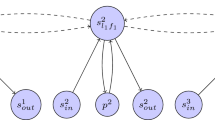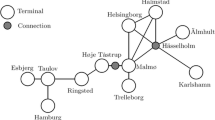Abstract
An efficient planning of future investments into a railway network requires a thorough analysis of possible effects. Therefore, a tool is needed for a costbenefit-analysis at an early stage of the planning process. We present a method to obtain a cost-benefit-curve that shows the effect of investments (cost) on the quality of the network measured by the waiting time of passengers (benefit).
This curve is obtained from the solutions of a multi-criteria timetable optimization problem. Timetables are evaluated with respect to the investment they require and the benefit they bring to passengers in terms of shorter waiting times. Moreover, we show how the notion of stability of a timetable under random delays can be included into our approach. The analysis is done on a strategic level without consideration of all operational details. We use genetic algorithms to find approximate solutions to the optimization problem.
A prototype system is presently tested on a network of regional lines in Germany. We report on the first very promising results.
Access this chapter
Tax calculation will be finalised at checkout
Purchases are for personal use only
Preview
Unable to display preview. Download preview PDF.
Similar content being viewed by others
Bibliography
Engelhardt-Funke, O. and M. Kolonko (2000). Optimal time-tables: Modelling stochastic pertubations. In Proceedings of the 7th International Workshop on Project Management and Scheduling (PMS 2000), Osnabrück, 125–127.
Goverde, R. (1998). Optimal transfertimes in railway time tables. In Abstracts of the 6th Meeting of the EURO Working Group on Transportation, Göteborg, Sweden, 1–5.
Herrmann, U. (1996). Untersuchung zur Verspätungsentwicklung von Fernreisezügen auf der Datengrundlage der R Z Ü Frankfurt am Main. Dissertation, TH Darmstadt.
Ishibuchi, H. and T. Murata (1996). Multi-objective genetic local search algorithm. In Proceedings of the IEEE International Conference on Evolutionary Computation, IEEE, Piscataway, 119–124.
Kolonko, M. and S. Voget (1998). Multidimensional optimization using fuzzy genetic algorithms. Journal of Heuristics 4, 221–244.
Mühlhans, E. (1990). Berechnung der Verspätungsentwicklung bei Zugfahrten. ETR — Eisenbahntechnische Rundschau 39, 465–468.
Nachtigall, K. (1996). Periodic network optimization with different arc frequencies. Discrete Applied Mathematics 69, 1–17.
Nachtigall, K. (1999). Periodic Network Optimization and Fixed Interval Timetables. Habilitation thesis, University Hildesheim.
Nachtigall, K. and S. Voget (1997). Minimizing waiting times in integrated fixed interval timetables by upgrading railway tracks. European Journal of Operational Research 103, 610–627.
Orlin, J.B. (1982). Minimizing the number of vehicles to meet a fixed periodic schedule: An application of periodic posets. Operations Research 30, 760–776.
Potthoff, G. (1970). Verkehrsströmungslehre 3: Die Verkehrsströme im Netz. Transpress VEB Verlag für Verkehrswesen, Berlin.
Serafini, P. and W. Ukovich (1989). A mathematical model for periodic scheduling problems. SIAM Journal on Discrete Mathematics 2, 550–581.
Suhl, L. and T. Mellouli (1999). Requirements for, and design of, an operations control system for railways. In N.H.M. Wilson (Ed.), Computer-Aided Transit Scheduling, Lecture Notes in Economics and Mathematical Systems, 471, Springer, Berlin, 371–390.
Weigand, W. (1981). Verspätungsübertragung in Fernverkehrsnetzen. ETR-Eisenbahntechnische Rundschau 30, 915–919.
Zimmermann, U. and T. Lindner (2000). Train Schedule Optimization in Public Transportation. Technical report, TU Braunschweig. Available at http://www.math.tu-bs.de/mo/research/preprints.html.
Author information
Authors and Affiliations
Editor information
Editors and Affiliations
Rights and permissions
Copyright information
© 2001 Springer-Verlag Berlin Heidelberg
About this chapter
Cite this chapter
Kolonko, M., Engelhardt-Funke, O. (2001). Cost-benefit-analysis of Investments into Railway Networks with Periodically Timed Schedules. In: Voß, S., Daduna, J.R. (eds) Computer-Aided Scheduling of Public Transport. Lecture Notes in Economics and Mathematical Systems, vol 505. Springer, Berlin, Heidelberg. https://doi.org/10.1007/978-3-642-56423-9_25
Download citation
DOI: https://doi.org/10.1007/978-3-642-56423-9_25
Publisher Name: Springer, Berlin, Heidelberg
Print ISBN: 978-3-540-42243-3
Online ISBN: 978-3-642-56423-9
eBook Packages: Springer Book Archive




